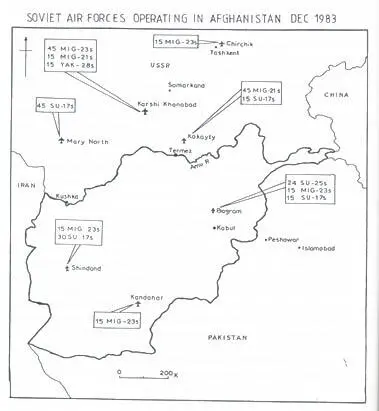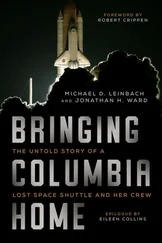By 1983 the Afghan Army was functioning again as a viable force. Its dispositions down to divisional level are shown on Map 3, but none of them exceeded 5000 men, making them at best brigades as far as numbers were concerned. One division, the 7th in Kabul, could only muster 1000, while battalions of 200 were not uncommon. Nevertheless, the total strength of the Army had climbed back up to 35,000 – 40,000 men. It was being utilized in the field to a limited extent and the Soviets were using it to fight the war along the Pakistan border. All the minor posts and garrisons in the east were manned by Afghans. In theory the Afghan High Command worked alongside the Soviets, there supposedly being a partnership to run the war. In practice this was nonsense, as all strategic and most tactical decisions were made by the Soviets. A Soviet military adviser looked over his Afghan opposite number’s shoulder from the headquarters of 40th Army in Kabul down to every isolated company post throughout the twenty-nine provinces. An Afghan officer disregarded his adviser at his peril. There seemed to be a widening rift between Soviet and Afghan commanders, with the former regarding the latter as a second-rate, even expendable, ally. I was later to read transcripts of intercepted radio messages in which Afghan officers complained that they were being ordered to undertake risky, dangerous missions, while the Soviets remained secure in base. I was certain there was little love lost between the two, although troth parties realized neither could survive without the other so they kept up a presence of fraternal cooperation.
I was especially keen to understand what was happening in the air. Airpower was assuredly the enemy’s greatest asset. It bestowed not only unlimited firepower, but also mobility. Used correctly, these two could be combined on the battlefield to defeat the guerrillas tactically, if not strategically. The problem from the Mujahideen’s point of view was not so much that they had no airpower of their own, but that their means of striking back at enemy planes and helicopters was restricted to a few outdated SA-7, shoulder-fired, surface-to-air missiles (SAMs). I will discuss this deficiency, and the air war, in detail in a later chapter but I would make the point here, as it was made to me on my arrival at ISI, that this lack of an effective and suitable anti-aircraft weapon was the most serious defect in the Mujahideen’s armoury. This situation was not to be remedied for another three years.

Discounting at least four helicopter regiments, the air map depicted Bagram Air Base as having the largest concentration with 54 fighter and fighter-bomber aircraft. Next was Shindand in the west with 45, and then Kandahar with 15. These planes were outnumbered by those stationed in the Soviet Union, but which regularly carried out sorties over Afghanistan. At that time our intelligence was showing 195 such aircraft based at Mary North, Karshi Khanabad, Kokayty and Chirchik—this latter being 350 kilometres north of the Amu (see Map 5).
As was explained to me, the Soviet fixed-wing aircraft were being used to attack villages which might be serving as Mujahideen bases. Close air support, that is attacking guerrillas in contact with communist ground troops, was limited. This task was invariably given to helicopter gunships rather than fighter-bombers. Heavy use of bombing in localized areas was a common way of exacting reprisals after a successful guerrilla ambush. Indiscriminate bombing was causing great destruction of villages and inflicting hundreds of civilian casualties. It did not normally do much harm to the Mujahideen, but it was the primary cause of the torrent of refugees flowing into Pakistan. I suppose this in itself was counted as a success by the Soviets, as the refugees became a growing source of discontent in Pakistan.
The Muiahideen feared the helicopter rather than the MIG or the SU-17, because he could not hit back at it. It had become a personal enemy, spitting shells at him from a few thousand feet with comparative impunity. The M1-24 Hind gunship was the Soviet’s battlefield workhorse of the war. Its armaments could include 12.7mm machine guns, 57mm rockets, HE, white phosphorus and incendiary bombs, air-dropped minelet pods, cluster bombs or chemical canisters. By late 1983, working in pairs, they could be seen providing close air support, rocketing villages, flying as convoy escorts and patrolling and destroying whatever they could find moving below them. As a transport helicopter, the Mi-8 or Mi-17 of the Hip series predominated. They were beginning to be used more effectively to air-land troops into blocking or cut-off positions during the larger sweep operations.
By mid-November I felt more confident that I was beginning to understand the Mujahideen and their enemies. It was time to consult General Akhtar on an overall long-term strategy for the war. We needed to decide priorities, to agree how best to improve the ability of the Mujahideen to defeat a superpower.
“There were 58,000 note 4 Note4 US
in Vietnam and we owe the Russians one…. I
have a slight obsession with it because of Vietnam, thought the Soviets
ought to get a dose of it.”
Congressman Charles Wilson, formerly an avid supporter of US assistance to the Mujahideen as quoted in the Daily Telegraph, 14 January 1985.
I ARRANGED Wilson’s visit into Afghanistan in 1987. It was something he had always wanted to do, as he had been an energetic and persuasive spokesman for the Mujahideen cause inside the House of Representatives for a number of years. He had proved a good supporter of the Jehad, and was well known to President Zia, to whom he had casually let slip that he was going inside Afghanistan. Zia, who was not aware that this had been arranged, kept a straight face but later sought out General Akhtar and forbade it. He did so for political reasons, in case news of it were to leak, and because of the slight risk of his becoming a casualty, or, much worse, taken prisoner. Zia wanted the water warm, not boiling hot. Wilson had also arrived with a lady friend who he had hoped would accompany him, but this would have proved embarrassing and risky to arrange.
Wilson had arranged his visit directly with Khalis’ Party, and we were unaware of it, as was the President. Although Zia vetoed the visit, he was adamant that Wilson should not know that he, or ISI, had prevented it. We concocted a plan whereby Wilson be allowed to approach the border, and then be stopped by Mujahideen on the pretext of inter-tribal fighting in the vicinity. This worked, and I went to Peshawar to escort him back to Islamabad. When he saw General Akhtar he was told that if he came back secretly arrangements would be made to get him into Afghanistan. Wilson duly returned and visited the Mujahideen base at Zhawar, some five kilometres into Afghanistan, opposite Miram Shah (see Map l). There he enjoyed himself, being photographed on a white pony dressed as a Mujahideen, with a bandolier of bullets across his chest. He was most excited when he came under spasmodic shellfire, although nothing landed closer than 200 metres. Because we had several Stingers with us we tried to tempt a helicopter to come within range, as the Mujahideen wanted to show off their skill, and Wilson was equally enthusiastic to see one brought down. Unfortunately, they kept well away. On his return he was furious that the US Embassy had, somewhat thoughtlessly, arranged for him to fly home via Moscow. He made a monumental fuss and refused to board the aircraft, so another flight had to be found for him. I still have his letter of thanks for this covert trip to the war.
Читать дальше













